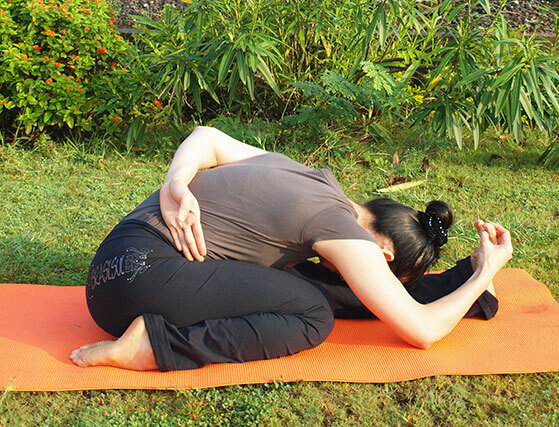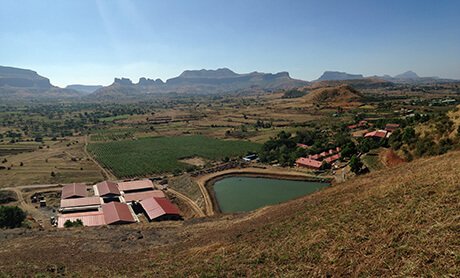
By Sannyasi Bhakti Ratna (Kate Woodworth) - Kate is a senior yoga teacher and yoga therapist from Yoga Vidya Gurukul (www.yogapoint.com), she is teaching and practicing yoga for the last 10 years. She is also Resident Officer at Yoga Vidya Gurukul. She is initiated into Karma Sannayasa by her Guru Swami Niranjanananda Saraswati.
Yoga practice during menstruation is a controversial issue. There are those who say that no woman should practice yoga during her menstruation, others say practice everything. Some say practice inversions, others say avoid. Some say a strong practice is useful, others say to practice restorative asanas.
All women are different with regards to menstruation. Some may not have any side effects, low energy or feel at all different than they do during the rest of the month, while others have such extreme pain, mood swings, fatigue, bloating, irritability and so on that they have to stay in bed for the first few days. Because no woman is the same there are no set rules regarding what to practice during menstruation but there are some general guidelines that can help. What is important is that we listen to our bodies during this time.
The menstrual cycle is very delicate. If we are stressed, travel; change our diet and so on then our cycle can change. It is very important to be aware of our cycle and to listen to our bodies. Those who do not may often have irregular periods or no periods along with many other symptoms. The state of our menstrual cycle reflects the state of our physical and mental health. Therefore it is not just asanas that can have an impact on it but also the mind, making meditation and reflection an important practice.
The menstrual cycle is very delicate. If we are stressed, travel; change our diet and so on then our cycle can change. It is very important to be aware of our cycle and to listen to our bodies. Those who do not may often have irregular periods or no periods along with many other symptoms. The state of our menstrual cycle reflects the state of our physical and mental health. Therefore it is not just asanas that can have an impact on it but also the mind, making meditation and reflection an important practice.
Menstruation time is a time of heightened awareness and sensitivity. Often the problems that we have during the month become more real at this time and affect us more strongly. At this time it is particularly useful to examine these problems and find solutions. Menstruation is a time to explore and look within. It is a time to nurture and heal the body and mind.
Again the way we look at our menstruation greatly differs between women. Some women prefer to ignore it as much as possible, to pretend or detach themselves from what is going on. These are generally the ones who are more competitive and out to prove that they are just as strong as men. Strength is good but we should also have the awareness of our bodies and give time to listen to them. It is not to say that we can all hang around the house not doing anything but we can treat our bodies with care and respect. We should put in efforts to remain balanced and therefore cultivate inner strength.
Some associate guilt, uncleanliness or other negative emotions. These may have come up due to the culture one has grown up, the views of one's parents or some other events in life. Relaxation techniques such as yoga nidra can be very beneficial for these women in clearing away these negativities and instead bringing acceptance and positivity of one's self.
The main reason why we may choose not to practice may be due to the associated symptoms of menstruation. If a woman is having very extreme menstruation then even the thought of practicing will cause negative emotions. The best practice at this time is then yoga nidra and some gentle pranayam such as bhramari (humming bee breath), anulom vilom (alternate nostril breath), ujjayi (victorious breath) and deep breathing. Om Chanting will also be very beneficial.
If we are not feeling too uncomfortable then a yoga practice can be useful to help alleviate any period pain or back pain, balance the emotions - mood swings, anxiety, anger, depression, irritability and gentle open the pelvic region, relieving any congestion. Menstruation is a time to vary ones yoga practice to look within and find the peace and tranquility.
In a yoga practice there are certain asanas that should be avoided during menstruation. The main type of asanas are inversions. These should be avoided throughout the menstruation. The reasoning for this is that when we practice inversions one type of prana, known as a apana, which normally flows in the downward direction from the manipur chakra (naval centre) to mooladhar chakra (cervix), is reversed. This is useful to help increase the prana in the body and to help awaken the kundalini but when menstruating it goes against the natural flow. It can therefore stop or disturb the menstruation at this time and lead to other reproductive problems later on. Another reason is that during inversions the uterus is pulled towards the head and causes the broad ligaments to be over stretched which cause partial collapse of the veins, leaving open arteries to continue pumping blood. This can lead to vascular congestion and increased menstrual bleeding. Previously people used to think that inversions could cause endometriosis and infections but it is now thought not to be the case.
Secondly, any very strong asanas particularly strong backbends, twists, arm balances and standing positions that put a lot of stress on the abdominal and pelvic region should be avoided, especially if the woman is going through a lot of pain at the time. The reasoning for this is very logical. If the pelvic region is causing spasm and pain why cause more contraction and pressure to the area. Also these positions need more physical strength and exertion which can be lacking during this time and can be depleted further by the practice. Strong vinyasa and power yoga should be avoided for the same reasons. Surya namaskar, when done slowly and gently, can be useful, however it should be avoided if there is a lot of pain or heavy bleeding.
Thirdly, bandhas should be avoided for similar reasons. On a pranic level they move the apana upwards instead of down and physically they add more contraction to an already tight region and in the case of uddiyan bandha increasing the heat which can lead to heavier bleeding. It may seem like there are many positions that cannot be practiced however this is not the case. Many positions can still be practiced and many more positions that may not be in ones daily practice can be incorporated and explored. It's all about listening to the bodies needs and accepting that this is a time of introversion, acceptance and balance.
Do remember that it is not necessary that you have to practice asanas during your period. For the first two days you may have a break from asanas. That doesn't mean you cannot practice other techniques such as pranayam, yoga nidra and meditation. All will have benefits. It is important that if you decide to practice that you should be aware of and listen to your body. Do not push or strain and instead do some more gentle poses but hold them a little longer. Generally it is good to practice positions that allow one to become more grounded, to alleviate any emotional disturbances and to gain inner strength.
To warm up one can practice the preparatory movements 1 to 12, arm movements, leg and knee movements. The pawanmuktasan series 1, 2 and 3 from Swami Satyananda are also recommended. Surya namaskar (Sun Salutation) can be practiced if there is no heavy bleeding or cramping. But it should not be performed in a fast manner. Chandra namaskar (Moon Salutation) is another alternative which is more soothing, harmonizing and calming at this time and helps to cultivate the feminine aspects.
Gentle forward bends give a light massage to the abdominal and pelvic region, helping to relieve congestion, heaviness, cramping and heavy bleeding. They also bring calmness to the mind. Examples include Paschimottanasan (Forward Bend),Ardha paschimottanasan (Half Forward Bend), Ugrasan (Ferocious Pose), Vajrasan Yoga Mudra Type 1 (Child's Pose), Shashankasan (Hare/Moon Pose) and Janu Bhalasan (Standing forward bend). Practice these positions to 50-60% of your capacity or with the support of cushions or bolsters. Do not strain or do strong forward bends. Vajrasan Yoga Mudra Type 1 and Shashankasan can be practiced with the knees further apart. Gentle twisting positions can remove back pain, cramping and congestion. Examples include leg movement type 2, vakrasan (Twisted Pose) type 1, preparatory movement 2 and 3 and gentle twists in sitting positions. Avoid very strong twisting positions.
Gentle backbends, especially when supported, can alleviate back pain and pelvic discomfort. Examples include Supta Vajrasan (Sleeping Thunderbolt) (sitting on heels or with heels apart)and Supta Titaliasana (Sleeping Butterfly) supported with bolsters. The Vajrasan series is also useful especially for removing tension from the back and to remove pelvic congestion. The whole series can be practiced or just a few of the poses. Avoid strong backbends.
Leg up the wall poses help to remove stagnant blood from the legs without lifting the pelvic region and help to open up the pelvic region. Legs can be straight up the wall or separated to a comfortable distance or with the soles of the feet together.
Other useful positions include Marjariasan (Cat Pose)and Vyaghrasan (Tiger Pose) which both help to remove back pain and pelvic tension. Titaliasan (Butterfly) to tone the pelvis, Sulabh Pawanmuktasan (Simple Gas Release Pose), with knees apart, to relieve back pain, Sulabh Koormasan (Simple Tortoise Pose), Simple Pigeon and simple supine spinal twists. This is not a complete list as there are thousands of asanas to choose from but just remember the guidelines and main points when choosing and practicing asanas.
Pranayam is very useful during menstruation as it helps to balance the emotions and calm the mind. It can also help one to deal with any pain. Do remember that there should be no strain with the breath and also no kumbakh and bandhas as these will increase the heat and redirect the prana in the upward direction. Deep breathing is very beneficial, especially when practiced in Tadagasan (Pond Pose) or Shavasan (Corpse Pose). Bhramari (Humming Bee Breath), Anulom vilom (Alternate Nostril Breathing), Ujjayi (Victorious Breath), Sheetali (Cooling breath through the tongue) and Sitkari (Cooling breath through the teeth)are all useful practices.
Avoid fast breathing, Bhastrika (Bellow's Breath), Surya Bedan (Right Nostril Breathing) and Kapalbhati (Frontal Brain Cleansing) as they will increase the heat which may cause heavier bleeding and will also put excessive pressure on the abdominal region.
Meditation is another useful practice at this time particularly as one is more sensitive and aware at this time. Om chanting and meditation on Om can be used. Antar mouna, the practice of inner silence is a technique where one observes ones thoughts. Chanting of personal mantra or mahamrityunjaya will give benefits as will simple meditation on the breath or ajapa japa. Yoga nidra is also strongly recommended at this time.
Some cleansing practices can be done at this time but most should be avoided. Jal neti and Danda neti can be performed as can Tratak but avoid Kapalbhati, Vaman, Lagoo Shankarprakshalan and Poorna Shankarprakshalan.
Many teachers say it is better to do your home practice during menstruation instead of going to a class. This is because many times during class one may feel compelled to follow all of the teacher's instructions. One may push themselves more when their body is not ready for it and one may practice inversions when these should be strictly avoided. The main reasons for this are that one does not want to be the odd one out and many women don't want others to know that they are having their period. Many teachers will give options to practice instead of inversions but if not just substitute one or more of the recommended asanas for during menstruation. Remember that you are practicing for yourself, not for your teacher or a friend, so it's always better to follow what you feel.
remember you can change it, add and remove positions, hold some for longer or shorter, just listen to the body...
1 Hour Practice
Many yoga techniques can be practiced throughout the month to help balance the hormones, the menstrual cycle and to prevent pre menstrual syndrome, period pain, emotional disturbances and other associated symptoms of menstruation
Asanas - Surya Namaskar (Sun Salutation), Sarvangasan (Shoulderstand), Halasan (Plough), Matsyasan (Fish), Kandharasan (Shoulder Pose), Ardha Chakrasan (Half Wheel), Chakrasan (Wheel Pose), Bhujangasan (Cobra),Shalabhasan (Locust), Dhanurasan (Bow), Paschimottanasan (Forward Bend), Ushtrasan (Camel), Viparit Karni (Inverted Pose), Sirshasan (Headstand), Ashwini Mudra (Horse Gesture), Aakarna Dhanurasan (Archer's Bow), Marjariasan (Cat), Garudasan (Eagle), Veerasan (Warrior), Trikonasan (Triangle).
Other - Yoga nidra, Antar Mouna, Om chanting, Bhramari (Humming Bee Breath), Ujjayi (Victorious Breath), Uddiyan Bandha (Uddiyan Bandha), Moola Bandha (Root Lock), Agnisar (Fire Breath).
By Sannyasi Bhakti Ratna (Kate Woodworth)
Phone - +91-9822770727
E-mail - yoga@yogapoint.com or yogapoint108@gmail.com

Yoga Vidya Dham, Kaivalya Nagari,
College Road, Nashik - 422005.
Maharashtra, India.
Phone - +91-9822770727 (for courses in ENGLISH)
+91-253-2318090 (For courses, in HINDI or MARATHI)
(Please call during 9.00 AM to 5 PM Indian Time)
E-mail - yoga@yogapoint.co or yogapoint108@gmail.com
Village Talwade, Trimbak, Nasik
Maharashtra,India.
Phone - +91-9822770727
E-mail - yoga@yogapoint.com or yogapoint108@gmail.com
